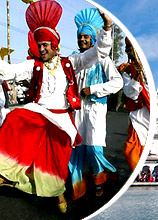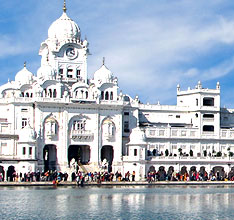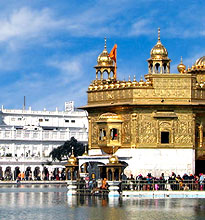 Punjab is inhabited by people of diverse socio-cultural dominations. The inhabitants of the state are called the Punjabis. They are basically of Indo-Aryan ethnic origin and belong to South Asia. Numerous settlers like the Indo-Aryans, Persians, Synthians, Greeks, Arabs, Afghans and the British have invaded and ruled the region, giving it a unique culture. Punjabis constitute about 3% of the total population of the country. As per 2001 census, population of the state was 2.44 crores. Let us explore the people and lifestyle of Punjab in detail.
Punjab is inhabited by people of diverse socio-cultural dominations. The inhabitants of the state are called the Punjabis. They are basically of Indo-Aryan ethnic origin and belong to South Asia. Numerous settlers like the Indo-Aryans, Persians, Synthians, Greeks, Arabs, Afghans and the British have invaded and ruled the region, giving it a unique culture. Punjabis constitute about 3% of the total population of the country. As per 2001 census, population of the state was 2.44 crores. Let us explore the people and lifestyle of Punjab in detail.People & Lifestyle Of Punjab
The population of Punjab is a homogeneous mixture of a variety of tribes and classes. The Greeks, Scythians, Parthians, Huns, Pathans and Mughals came here, settled down and got woven into its cultural fabric. Among the various tribes, the most dominant ones are the Jats, Khatris, Aroras, Brahmans, Vaishas, Lohars, Gujjars, Tarkhans and Sansins. Some minority tribes residing in the area are Awans, Arians, Kalals, Ahluwalias, Labanas, Pathans, Nais, Sainis, Kambohs and Soods. Most of them can be further sub-divided into clans and family groups. Some other tribes include Banias, Bhatias, Brahmins and Chhimbas. Some of these tribes have Arabian, Persian and Turkish heritage.
Sikh Jat is the biggest community settled in Punjab. They are expert in agriculture and contribute significantly towards the regional agricultural output. The Khatris and Aroras are next in number. The Khatris are sub-divided into many groups; the most significant of them being the Dhaighares, Charzatis, Punjzatis, Chhezatis, Sarins, Bahris and the Khakhrains. Khatris claim to be in the direct line of the Kshatriyas of the Aryan race. The Aroras also claim to be of Khatri origin. The minority tribes in the state are occupied in agricultural operations as well as local trading operations.
Among the minor agricultural tribes in Punjab, Sainis and Kambohs are the most prominent ones. The Sainis claim their origin from the Rajputs, while Kambohs are from "Kamboj Desh” in Afghanistan. They, along with other minorities like Bawris, Bazigars and the Pakhiwaras, have retained their aboriginal customs and beliefs. Every village in Punjab has its own customs and rituals. Every community has its own social customs, which are unique to it. Even when a Jat and Khatri are next-door neighbors, some of their cultural traits vary a lot. Despite such a wide diversity, a common thread of homogeneity binds the Punjabis as a whole. The people with ethnic diversity blend together to represent a veritable aura of multi-dimensional bondage and brotherhood.











